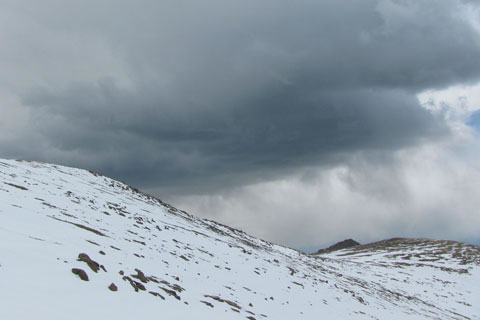| 331 | Hiking Skills - The Ten Essentials - Shelter | 2011-01-10 |

Storm on Pikes Peak, Crags Route
While climbing Mount Wilson (Colorado) at around 14,000 foot we encountered a major storm just short of the summit. We had already climbed Wilson Peak earlier that day and had been entertaining the idea of traversing to El Diente; but the skies were growing dark. We were high on the mountain and just needed a few more minutes. We didn't get them.
We had left the Navajo Lake trailhead at 2 that morning and practiced sleep walking as we stumbled along the rough trail to the lake. The majestic Wilson Peak was a crumbly mountain and took more time than we expected to safely climb and descend. Returning to Navajo Basin we began the ascent of Mount Wilson. The snow was hard and the steep slopes made us pay attention to each foot placement as we slowly ascended.
Nearing the summit ridge the threatening clouds inched closer. We only needed a few more minutes before we made the summit, but the storm delayed our ascent. As quickly as possible we prepared ourselves to hunker down in the fury of the storm. Snow, sleet, and hail danced to the thunder of lightning bolts. Wearing all of our clothes, topped by waterproof rainwear, we sat shivering as the storm raged. For over an hour we endured wave after wave of weather before we saw any signs that the storm might weaken. Because we were wearing waterproof rain gear we did not bring out the emergency shelter; but we knew where it was located if we needed it.
Two tired bodies descended the mountain and finally returned to the trailhead. We were confident our being prepared had helped keep us safe on the mountain. The extra gear weighs more; but when you need it, you really need it.
If we had needed more shelter from the storm, we would have used our mylar blankets. We always carry some form of shelter. We generally make a choice of which type shelter we want to use. For example: if we are truly backpacking, our shelter is our tent, but if we are day hiking we might bring just waterproof rain gear, or rain gear and a mylar blanket, tarp, or bivy sack. There are many workable solutions for shelter. Shelter should be planned with due consideration to the clothing you bring.
Shelter is one of the ten essentials. Always bring shelter suitable for the weather or conditions.
A few shelter tips ...
- Find a lightweight solution, because a heavier product would beg to be left in the garage.
- The shelter should be waterproof.
- A shelter might also be needed in the case of injury or illness.
- Use your pack to extend your shelter. Sit on your pack or if it has a removable back pad, sit on the back pad and put your feet in the sack.
- If your pack does not have a back pad, it might be a good idea to cut a small piece to carry with the shelter.
- Look for natural shelter to help. In an electrical storm being under a small overhang seems natural but is not the answer. That position leaves you very vulnerable to the flow of the electric current. A stand of trees or windbreak will provide some shelter.
- Put on all your clothes.
- Stay as warm and dry as possible.
- A small tarp could be pitched, but would probably not be very stable.
- If you have to pitch a shelter, leave yourself enough time for the work before the storm arrives.
What we use (we would choose one depending on the trip) ...
- Waterproof rain gear - this is not the breathable stuff, this is lightweight, waterproof rain gear. We wear breathable, water repellant gear and carry the light waterproof to wear if we have to hunker down. The combination weighs less than many do-it-all rain coats.
- Mylar tarps (space blankets) - the small light blanket. Inexpensive, but not much protection.
- Silnet tarp - a small, waterproof tarp. We could make a shelter with the tarp and hiking poles or use it as a wrap.
- Bivy sack - for serious shelter issues. They are the heaviest of the shelters, but provide the most protection.
- Tent or sleeping tarp - we could also pack our sleeping shelter if we were on a backpacking trip.
Adventure Medical makes a couple of interesting emergency shelter products, but we have not tried them. The heat sheet and SOL bivies are lightweight and maybe functional!
Shelters do not seem necessary until you need them. At least put a small mylar blanket in the bottom of your pack. If you ever meet an occasion to use it, you will be glad you packed it.
Happy sheltered trails.
Links to Essentials
